Investigation of Structural, Morphological, Optical, and Dielectric Properties of Magnesium Chromite (MgCr2O4) Spinel Oxide †
Abstract
1. Introduction
2. Experimental Methods
3. Results and Discussion
3.1. XRD Analysis
3.2. Functional Group Analysis
3.3. SEM-EDAX Analysis
3.4. UV-DRS Analysis
3.5. Dielectric Analysis
4. Conclusions
Author Contributions
Funding
Institutional Review Board Statement
Informed Consent Statement
Data Availability Statement
Acknowledgments
Conflicts of Interest
References
- Kholil, I.; Bhuiyan, M.T.H. Physical properties of spinel-type superconductors CuRh2S4 and CuRh2Se4: A DFT study. Results Phys. 2019, 12, 73–82. [Google Scholar] [CrossRef]
- Mansour, A.M.; Morsy, M.; El Nahrawy, A.M.; Abou Hammad, A.B. Humidity sensing using Zn(1.6−x)Na0.4CuxTiO4 spinel nanostructures. Sci. Rep. 2024, 14, 562. [Google Scholar] [CrossRef]
- Salomão, R.; Bôas, M.O.C.V.; Pandolfelli, V.C. Porous alumina-spinel ceramics for high temperature applications. Ceram. Int. 2011, 37, 1393–1399. [Google Scholar] [CrossRef]
- Gao, F.; Tang, X.; Yi, H.; Zhao, S.; Zhu, W.; Shi, Y. Mn2NiO4 spinel catalyst for high-efficiency selective catalytic reduction of nitrogen oxides with good resistance to H2O and SO2 at low temperature. J. Environ. Sci. 2020, 89, 145–155. [Google Scholar] [CrossRef] [PubMed]
- Narayanasamy, A. Magnetic properties of nanostructured spinel ferrites and nanocomposite Nd2Fe14B/α-Fe permanent magnets. Pramana 2005, 65, 893–900. [Google Scholar] [CrossRef]
- Chambers, S.A.; Droubay, T.C.; Kaspar, T.C.; Nayyar, I.H.; McBriarty, M.E.; Heald, S.M.; Keavney, D.J.; Bowden, M.E.; Sushko, P.V. Electronic and Optical Properties of a Semiconducting Spinel (Fe2CrO4). Adv. Funct. Mater. 2017, 27, 1605040. [Google Scholar] [CrossRef]
- Javed, M.; Khan, A.A.; Ahmed, M.S.; Khisro, S.N.; Kazmi, J.; Bilkees, R.; Khan, M.N.; Mohamed, M.A. Temperature dependent impedance spectroscopy and electrical transport mechanism in sol-gel derived MgCr2O4 spinel oxide. Phys. B Condens. Matter. 2020, 599, 412377. [Google Scholar] [CrossRef]
- Goud, T.A.; Charan, G.V. Influence of Ce on structural and electrical properties on Mg nano chromites synthesized by Citrate Gel Auto Combustion method. IOSR J. Appl. Chem. IOSR-JAC 2023, 16, 11–17. [Google Scholar] [CrossRef]
- Lenaz, D.; Skogby, H.; Princivalle, F.; Hålenius, U. Structural changes and valence states in the MgCr2O4-FeCr2O4 solid solution series. Phys. Chem. Miner. 2004, 31, 633–642. [Google Scholar] [CrossRef]
- Mykhailovych, V.; Kanak, A.; Cojocaru, Ş.; Chitoiu-Arsene, E.-D.; Palamaru, M.N.; Iordan, A.-R.; Korovyanko, O.; Diaconu, A.; Ciobanu, V.G.; Caruntu, G.; et al. Structural, optical, and catalytic properties of MgCr2O4 spinel-type nanostructures synthesized by sol–gel auto-combustion method. Catalysts 2021, 11, 1476. [Google Scholar] [CrossRef]
- Lin, G.T.; Tong, W.; Luo, X.; Chen, F.; Yin, L.; Wang, Y.; Hu, L.; Zou, Y.; Yu, L.; Song, W.; et al. Magnetocrystalline interactions in spinel MnCr2O4 single crystal probed by electron spin resonance. J. Alloys Compd. 2017, 711, 250–257. [Google Scholar] [CrossRef]
- Hirohata, A.; Yamada, K.; Nakatani, Y.; Prejbeanu, I.-L.; Diény, B.; Pirro, P.; Hillebrands, B. Review on spintronics: Principles and device applications. J. Magn. Magn. Mater. 2020, 509, 166711. [Google Scholar] [CrossRef]
- Habi Ben Hariz, S.; Lahmar, H.; Rekhila, G.; Bouhala, A.; Trari, M.; Benamira, M. A novel MgCr2O4/WO3 hetero-junction photocatalyst for solar photo reduction of hexavalent chromium Cr(VI). J. Photochem. Photobiol. A Chem. 2020, 430, 113986. [Google Scholar] [CrossRef]
- Jamil, Y.; Jeyakumar, G.P.; Deivasigamani, G. Investigation of Transition Metal Ions Cu2+ and Mg2+ Doped Zinc Aluminate (ZnAl2O4) and Their Structural, Spectral, Optical, and Dielectric Study for High-Frequency Applications. Mater. Proc. 2023, 14, 2. [Google Scholar] [CrossRef]
- Yasmin, P.; Gracie, J.; Geetha, D. Effect of cerium substitution on structural, optical, electrical transport and magnetic properties of spinel cobaltite synthesized through citrate-nitrate method. J. Mater. Sci. Mater. Electron. 2024, 35, 293. [Google Scholar] [CrossRef]
- Arunkumar, M.; Nesaraj, A.S. Photocatalytic degradation of malachite green dye using NiAl2O4 and Co doped NiAl2O4 nanophotocatalysts prepared by simple one pot wet chemical synthetic route. Iran. J. Catal. 2020, 10, 235–245. [Google Scholar]
- Elakkiya, V.; Agarwal, Y.; Sumathi, S. Photocatalytic activity of divalent ion (copper, zinc and magnesium) doped NiAl2O4. Solid State Sci. 2018, 82, 92–98. [Google Scholar] [CrossRef]
- Trukhanov, S.V.; Trukhanov, A.V.; Vasiliev, A.N.; Balagurov, A.M.; Szymczak, H. Magnetic state of the structural separated anion-deficient La0.70Sr0.30MnO2.85 manganite. J. Exp. Theor. Phys. 2011, 113, 819–825. [Google Scholar] [CrossRef]
- Trukhanov, S.V.; Trukhanov, A.V.; Vasiliev, A.N.; Szymczak, H. Frustrated exchange interactions formation at low temperatures and high hydrostatic pressures in La0.70Sr0.30MnO2.85. J. Exp. Theor. Phys. 2010, 111, 209–214. [Google Scholar] [CrossRef]
- Rahman, M.M.; Hasan, N.; Hoque, M.A.; Hossen, M.B.; Arifuzzaman, M. Structural, dielectric, and electrical transport properties of Al3+ substituted nanocrystalline Ni-Cu spinel ferrites prepared through the sol–gel route. Results Phys. 2022, 38, 105610. [Google Scholar] [CrossRef]
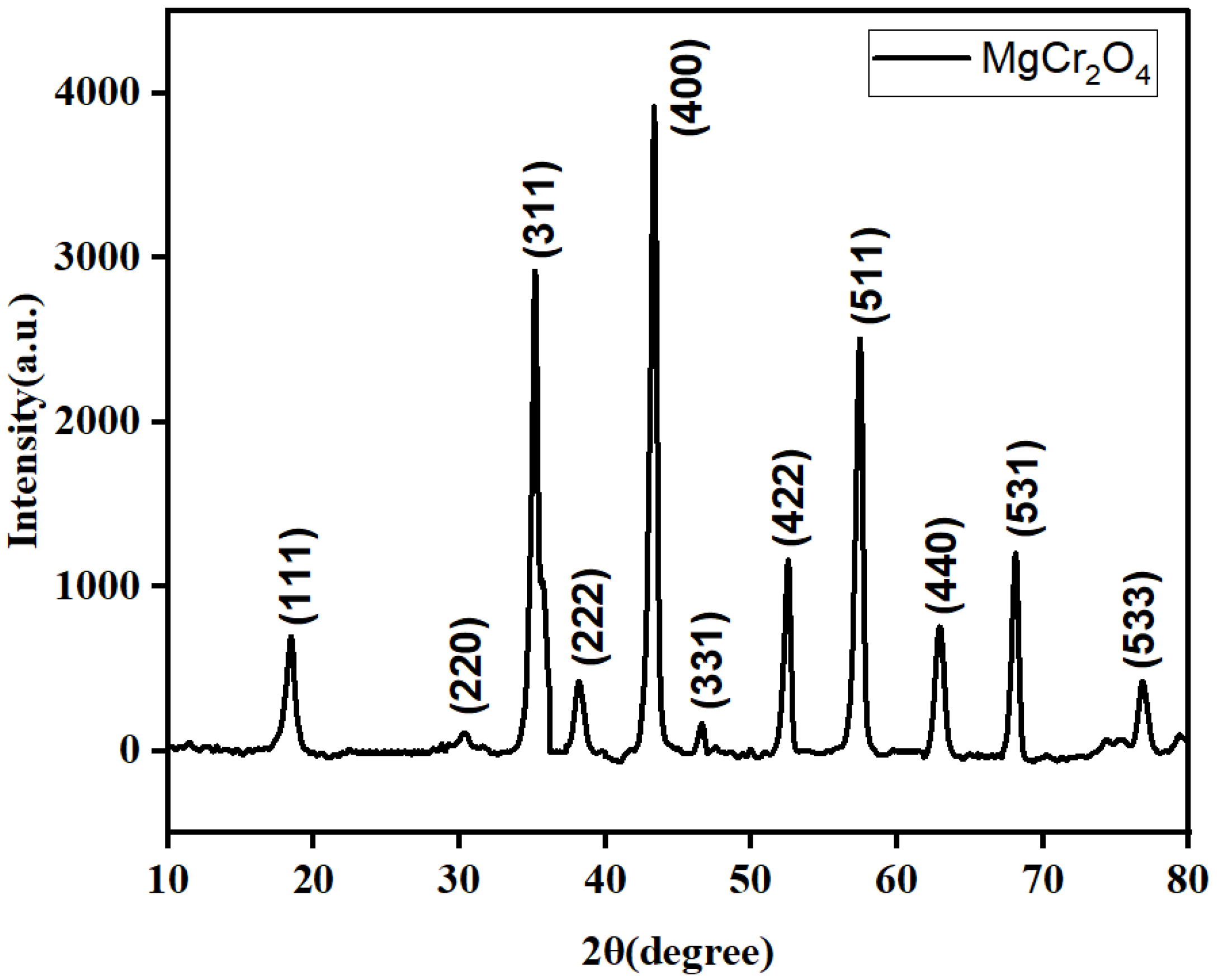
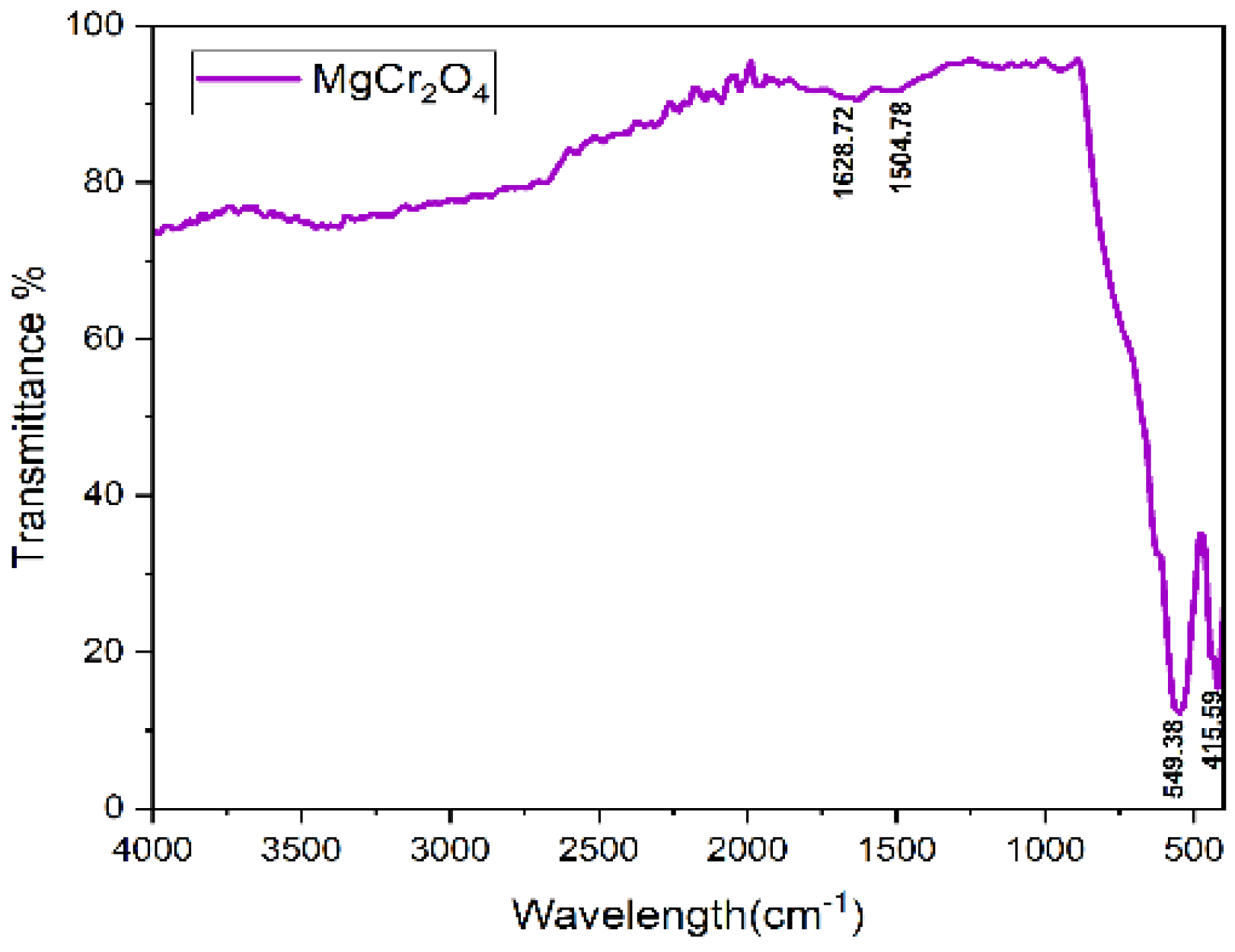
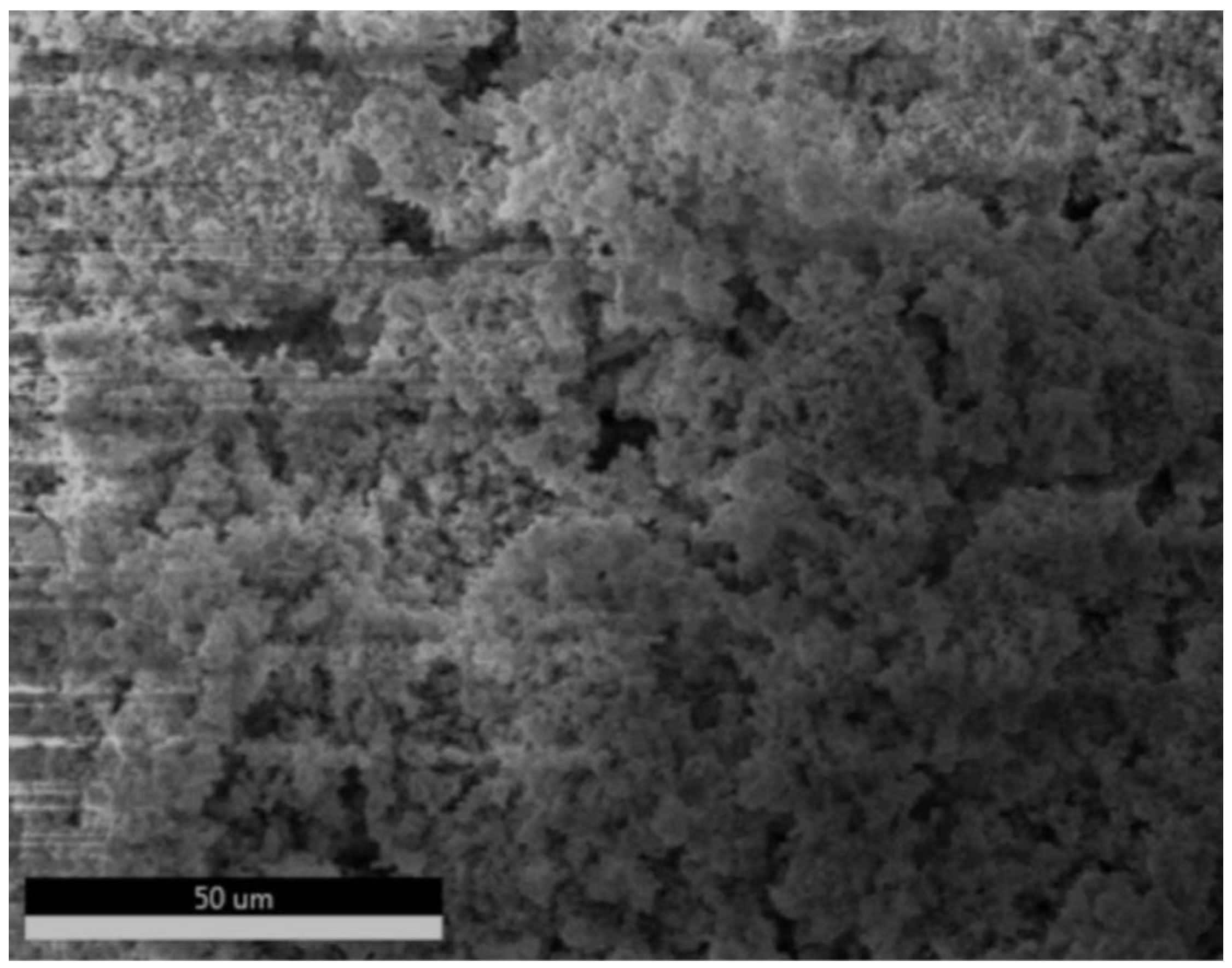
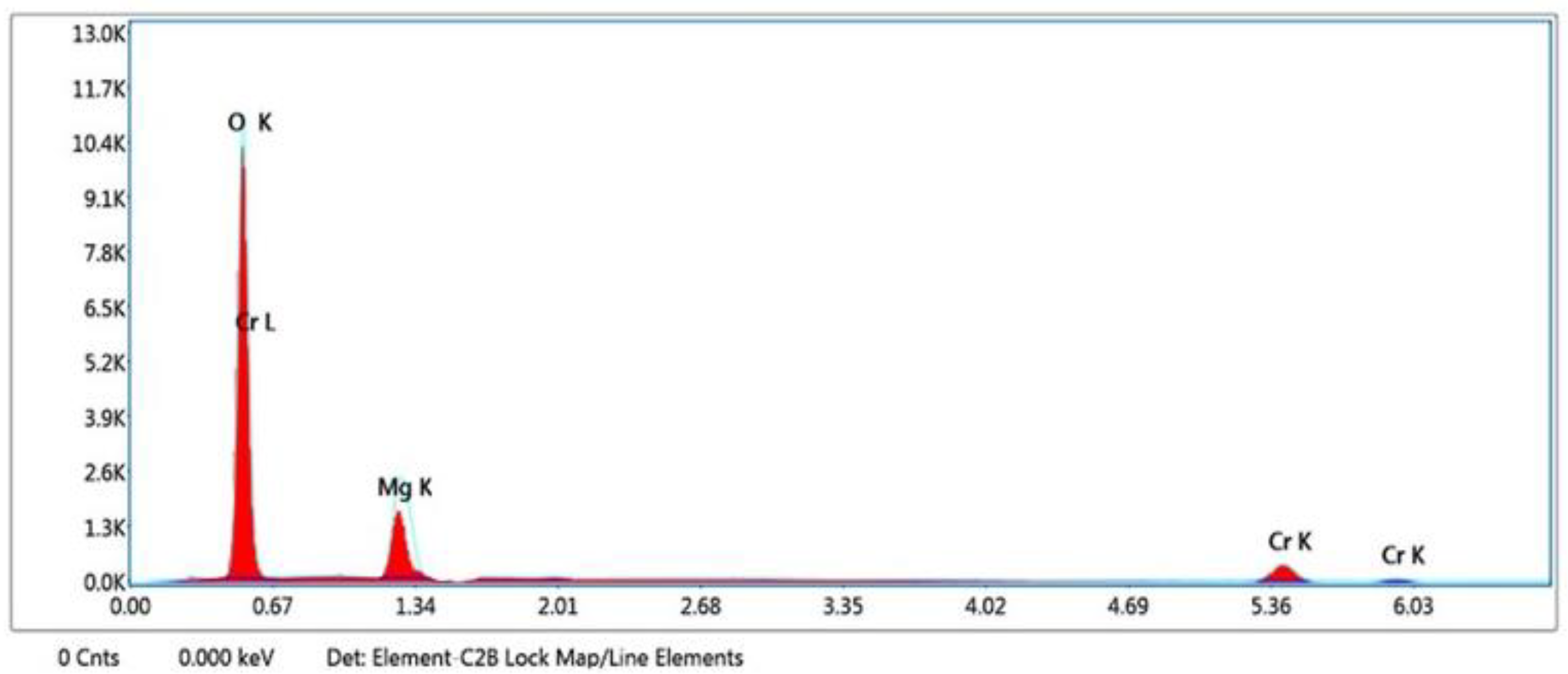

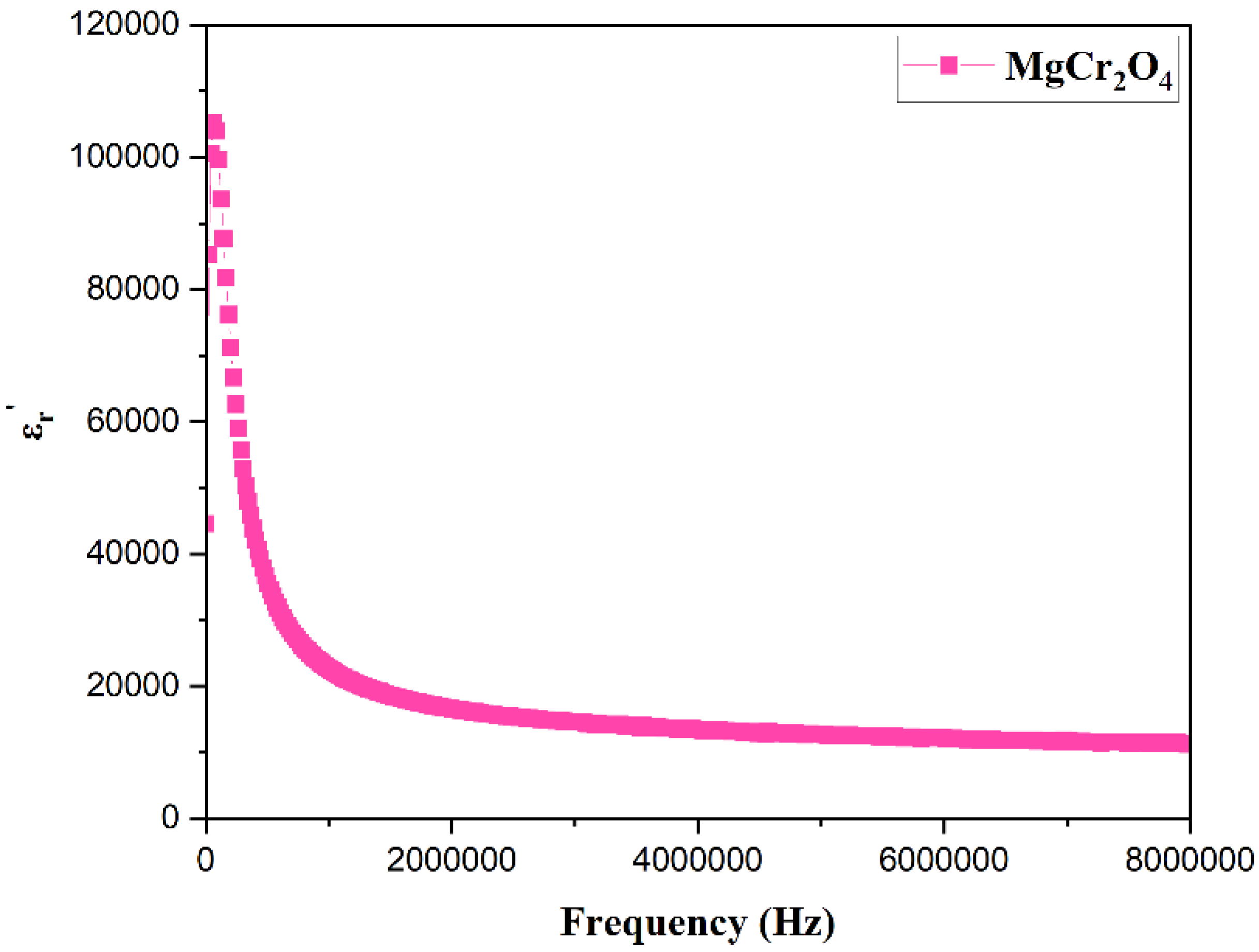

| Parameter | Values | Parameter | Values |
|---|---|---|---|
| Crystallite size (D) (nm) | 15.38 | Dislocation density (δ) (10−3/m2) | 0.004 |
| Interplanar distance (d) Å | 2.08 | Micro-strain (ε) | 1.15 |
| Crystal structure | Cubic FC | X-ray density Dx (g/cm3) | 1.93 |
| Volume of the unit cell (a3) Å | 631.48 | Specific surface area S (cm2/g) | 2.02 |
| Lattice constant Å | 8.54 | Packing factor P | 7.36 |
| Polaron radius γ (Å) | 1.50 | Stacking fault SF | 0.39 |
| Element | Weight % | Atomic % |
|---|---|---|
| O | 41.00 | 63.82 |
| Mg | 14.51 | 14.86 |
| Cr | 44.50 | 21.31 |
Disclaimer/Publisher’s Note: The statements, opinions and data contained in all publications are solely those of the individual author(s) and contributor(s) and not of MDPI and/or the editor(s). MDPI and/or the editor(s) disclaim responsibility for any injury to people or property resulting from any ideas, methods, instructions or products referred to in the content. |
© 2025 by the authors. Licensee MDPI, Basel, Switzerland. This article is an open access article distributed under the terms and conditions of the Creative Commons Attribution (CC BY) license (https://creativecommons.org/licenses/by/4.0/).
Share and Cite
Gurusamy, P.; Gnanasekar, A.; Deivasigamani, G. Investigation of Structural, Morphological, Optical, and Dielectric Properties of Magnesium Chromite (MgCr2O4) Spinel Oxide. Eng. Proc. 2025, 87, 109. https://doi.org/10.3390/engproc2025087109
Gurusamy P, Gnanasekar A, Deivasigamani G. Investigation of Structural, Morphological, Optical, and Dielectric Properties of Magnesium Chromite (MgCr2O4) Spinel Oxide. Engineering Proceedings. 2025; 87(1):109. https://doi.org/10.3390/engproc2025087109
Chicago/Turabian StyleGurusamy, Pavithra, Anitha Gnanasekar, and Geetha Deivasigamani. 2025. "Investigation of Structural, Morphological, Optical, and Dielectric Properties of Magnesium Chromite (MgCr2O4) Spinel Oxide" Engineering Proceedings 87, no. 1: 109. https://doi.org/10.3390/engproc2025087109
APA StyleGurusamy, P., Gnanasekar, A., & Deivasigamani, G. (2025). Investigation of Structural, Morphological, Optical, and Dielectric Properties of Magnesium Chromite (MgCr2O4) Spinel Oxide. Engineering Proceedings, 87(1), 109. https://doi.org/10.3390/engproc2025087109






